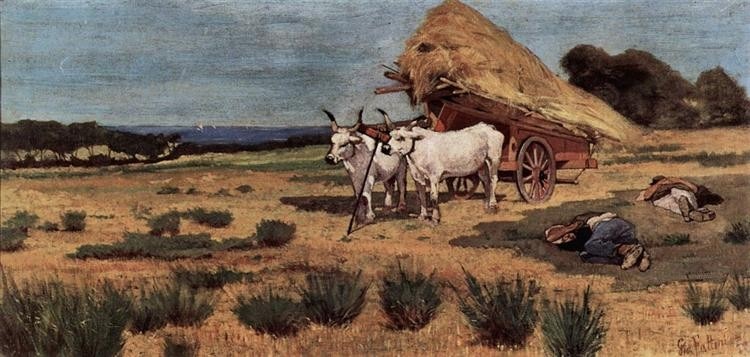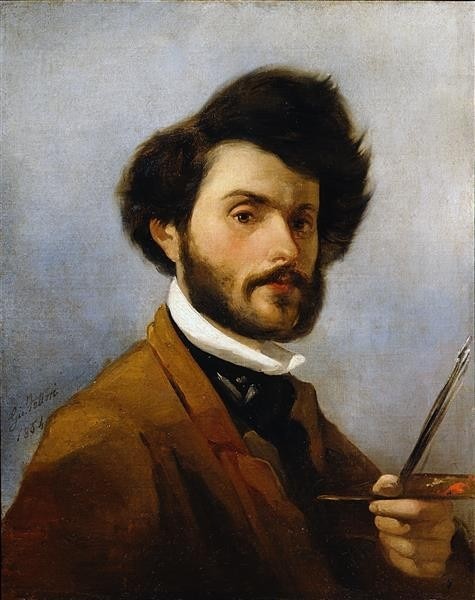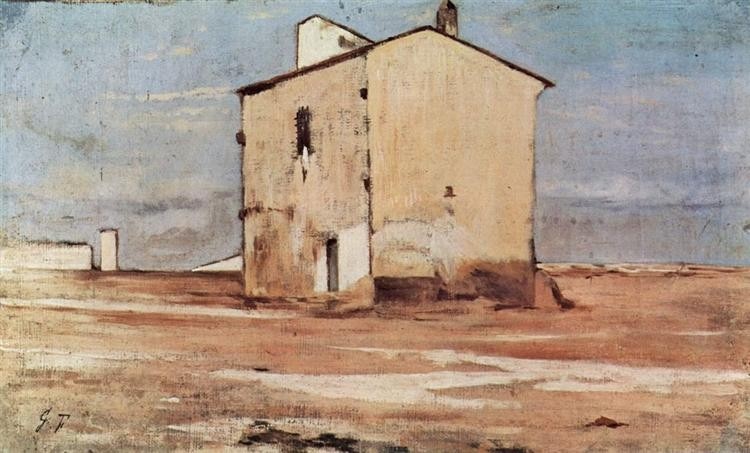Livorno, 1825. A vibrant port, a crossroads of souls and goods, a fertile womb where the city’s vital energy was about to coalesce into art. Here, on the sixth of September, Giovanni Fattori was born, the poet of Tuscan light, the master of the ‘macchia’, the artist who would capture the very soul of his land and immortalize it on canvas.
The son of a humble craftsman, Fattori grew up in a popular reality, breathing the salty air of the port and observing the daily life that unfolded around him. This direct contact with real life, free from any artifice, would shape his art – a frank and authentic realism, far from the affectations and idealizations of the Academy.
Fattori does not idealize his subjects but represents them with disarming sincerity, capturing their humanity and fragility.

His artistic education began in Florence where he attended the Academy of Fine Arts. He immersed himself in the cultural turmoil that animated the city. It was there that he met other young painters who, like him, aimed to renew Italian painting, freeing it from the constraints of tradition. This led to the rise of the Macchiaioli movement, with Fattori becoming one of its leading figures. This group of artists, who used to meet at the Caffè Michelangiolo, rebelled against official art, suggesting a style based on direct observation of nature and the use of contrasting patches of color to depict light and shadow.
The “macchia,” this revolutionary painting technique, would become Fattori’s signature style. In his works, light is the real protagonist, shaping forms and creating evocative atmospheres. The swift and decisive brushstrokes, typical of the “macchia,” give his paintings a freshness and spontaneity that make them immediately recognizable. The human figures, often depicted in their everyday lives, achieve an extraordinary dignity and expressive power. Fattori does not idealize his subjects but represents them with disarming sincerity, capturing their humanity and fragility.

Let’s consider, for example, The Palmieri Baths Roundabout (1866). Here, Fattori does not merely engage in a passive recording of sensory data; instead, he captures the very essence of the Tuscan summer. The dazzling light becomes substance, sculpting shapes and saturating the atmosphere. The female figures, immersed in this light, seem to lose their contours, almost merging with the surrounding environment. The decentralized composition breaks with traditional patterns, generating a sense of dynamism and vitality. The swift and decisive brushstrokes impart a surprising freshness and immediacy to the painting. The work, in its apparent simplicity, reveals a deep understanding of luminous and chromatic values, as well as an extraordinary ability for formal synthesis.

In vedetta (1873) represents another key moment in Fattori’s poetics. The landscape, with its horizontal lines stretching infinitely, takes on a dominant role, evoking a sense of vastness and solitude. The figures of the soldiers, tiny and isolated, seem to vanish into this immensity, emphasizing the precariousness of the human condition in the face of nature. Once again, light plays a fundamental role, creating strong contrasts that intensify the drama of the scene. The work, laden with tension, leaves the viewer in a state of suspended wait.
His painting, free from academicism and rhetoric, still speaks to us today with its expressive power and truth.
Fattori does not limit himself to landscape and genre painting. His artistic production also embraces historical and military themes, as in The Italian Camp at the Battle of Magenta (1861-1862), and The Cavalry Charge in Montebello (1861). In this works, Fattori deals with epic subjects, but he does so with a disenchanted gaze, far from celebratory rhetoric. His focus is on the details of the soldiers’ daily lives and the scars left by the war on the landscape, creating a powerful and realistic image of the conflict.

An all-round artist, Fattori was capable of exploring various pictorial genres, always with a keen eye for reality and a deep human sensitivity. His painting, free from academicism and rhetoric, still speaks to us today with its expressive power and truth. In an increasingly virtual and artificial world, Fattori’s art reminds us of the value of direct observation and authenticity.
Opening image: Giovanni Fattori, Knacker’s yard in Livorno, 1865-1867

